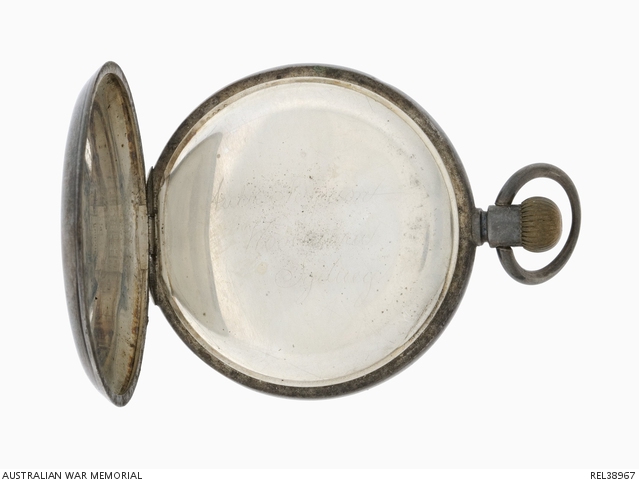| Places | |
|---|---|
| Accession Number | REL38967 |
| Collection type | Heraldry |
| Object type | Heraldry |
| Physical description | Brass, Silver |
| Maker |
Henry & Co. London |
| Place made | United Kingdom: England, Greater London, London |
| Date made | c 1900s |
| Conflict |
First World War, 1914-1918 |
Silver pocket watch: Private Archibald Leslie Ferguson, 18 Battalion AIF



Silver pocket watch made by Henry and Co. of London. The front and back covers are engraved with swirling cross-hatched patterned background. In the centre of the front cover is engraved an image of a garter with buckle. Within this is a shield design. At the top of the pocket watch is the winding device which also doubles as the button to open the front of the watch. Attached to the base of the winding mechanism, is the loop to attach a chain or lanyard. In the centre of the back plate is a small engraved circle with another engraved within. On the inside of the front and back covers are impressed the details 'F T' below that in an engraved rectangle are the numbers '0,935' below that are stamped two lions rampant and below them the serial number '2260856 / 6560'. On the inside of the back cover has been scratched '14/8/16'. On the cover for the mechanism 'ARCHIE FERGUSON / WOOLLHARA / SYDNEY' has been engraved in a cursive script. On the inside of this cover has been impressed the same details as on the front and back covers. '14/8/16' has been scratched into the surface. On the inside edge, five notches have also been marked. On the outside rim of the working parts, the number '6560' has been impressed. Engraved on one of the working parts is a scale with the words 'FAST' at the top and 'SLOW' at the bottom.
Associated with the service of 6070 Private Archibald Leslie Ferguson, who was born in Goulburn, NSW on 2 June 1888. Ferguson enlisted in the town of Wingello, NSW on 14 August 1916 . He initially joined 2 Battalion but transferred to 18 Battalion on 12 September 1916. He embarked from Sydney with 17 reinforcements of 18 Battalion on 25 October in HMAT Ascanius and arrived in Devonport, England on 28 December. Ferguson was admitted to hospital on 4 January 1917 with a broken leg. He spent several months recovering before being moved to 5 Training Battalion on 20 April. On 9 July, he proceeded overseas to France where he was taken on strength of 18 Battalion who were in camp at Bapaume. In Early September, the battalion moved to Belgium to prepare for their role in the fighting around Menin Road. On 20 September, the battalion moved off from Bellewaarde Ridge to their attack positions on Westhoek ridge. The battalion attacked at 5:40 am and were caught in a heavy German barrage causing many casualties. Ferguson received a shrapnel wound to his left hip and over the next two weeks was moved to England to recover. He returned to France and rejoined his battalion who were now in rest positions near Lumbres in France on 13 February 1918. Ferguson next saw action when the German Army launched its spring offensive on the Western Front. The battalion went into action near Villers Brettoneux in early April and moved to positions in Hangard Wood on 13 April. Ferguson was wounded for the second time on 15 April when he received gunshot wounds to his head and back. After hospitalisation and recovery in Rouen, he returned to duty on 6 May. Early on the morning of 29 May, the battalion was in the lines near Ville Sur Ancre and came under a sustained bombardment. The Germans fired mustard gas and high explosive shells into the line causing several casualties. Ferguson and several other men were badly gassed and evacuated. Ferguson was evacuated to England to recover, but due to the severity of his gassing, was unable to rejoin his unit. He returned to Australia on 19 October, arriving home on 27 December. He was still suffering the effects from the mustard gas and was hospitalised in Sydney for two more years. He was finally discharged from the AIF on 18 December 1920. This watch commemorates Ferguson's enlistment and may have been given to him to mark the event.
Related information
Conflicts
Places
Subjects
People
Related Objects
- British War Medal : Private A L Ferguson, 18 Battalion AIF
- Victory Medal : Private A L Ferguson, 18 Battalion AIF
- Shaving kit : Sapper R L Ferguson, Citizen Military Forces
- Pattern 1907 metal identity disc with medallions: Private A L Ferguson, 18 Battalion AIF
- Identity bracelet : Private A L Ferguson, 18 Battalion AIF
- Coin holder : Private A L Ferguson, 18 Battalion AIF
- Handkerchief : Private A L Ferguson, 18 Battalion AIF
- Handkerchief : Private A L Ferguson, 18 Battalion AIF
- Handkerchief : Private A L Ferguson, 18 Battalion AIF
- Handkerchief : Private A L Ferguson, 18 Battalion AIF